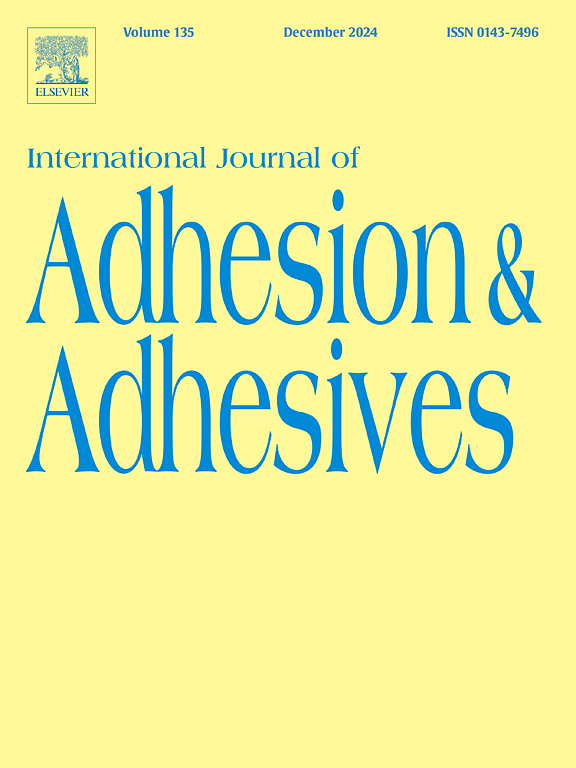Testing condition during mechanical cycling: Does it matter and how does it compare to thermocycled and uncycled composite restoration?
IF 3.5
3区 材料科学
Q2 ENGINEERING, CHEMICAL
International Journal of Adhesion and Adhesives
Pub Date : 2025-07-29
DOI:10.1016/j.ijadhadh.2025.104106
引用次数: 0
Abstract
This study aimed to evaluate the μTBS and failure mode of resin composite restorations bonded to dentin and aged through different testing conditions during mechanical cycling in comparison to thermocycled and uncycled conditions. Fifty sound third molars were sectioned, restored with resin composite (Filtek Z350 XT, 3M/Solventum), and embedded in polyester resin and low viscosity vinyl polysiloxane (Panasil, Ultradent Products). Fifty teeth were allocated into the following five groups (n = 10): MCDI - mechanically cycled in distilled water, MCAS - mechanically cycled in artificial saliva, MCDC - mechanically cycled under dry conditions, TC - thermocycled and CO - control (left uncycled). Mechanical cycling was performed using 500,000 fatigue cycles under a 130 N load at 2 Hz in an electromechanical testing machine (MSFM, ElQuip), while thermal cycling (MCT, Elquip) was conducted for 5000 times. All samples were then sectioned into beams (1 mm2) and subjected to μTBS testing in a universal testing machine (EZ Test, Shimadzu). Subsequently, failure modes were evaluated under a stereomicroscope and classified as adhesive (AD), cohesive within dentin (CD), cohesive within resin (CR), or mixed (MX). Data were analyzed using one-way analysis of variance, Tukey's test and chi-square test (α = 0.05). MCDI, MCAS and MCDC groups did not differ in μTBS, but showed significantly lower values than CO group (p = 0.009). TC did not differ from any of the other four groups. Groups differed in failure mode (p = 0.004), with AD ruptures being predominant in the groups MCDI and MCAS. MCDC group had significantly lower frequency of AD failures. CR failures was the most common type failure in the TC group. In the MCDI group, the proportion of CR failure was 2.5 times higher than CD failure, but reversed in the MCAS group. It was concluded that as far as the occurrence of aging of resin composite-dentin interface is a goal, regardless of the testing condition, mechanical cycling would be preferable over thermal cycling, as the latter did not cause discernible reduction in bond strength in comparison to uncycled counterparts.
机械循环中的测试条件:是否重要?与热循环和非循环复合材料修复相比如何?
通过不同的试验条件,对比热循环和非循环条件,研究树脂复合修复体在机械循环过程中与牙本质结合老化的μTBS和破坏模式。50颗健全的第三磨牙切片,用树脂复合材料(Filtek Z350 XT, 3M/Solventum)修复,并嵌入聚酯树脂和低粘度乙烯基聚硅氧烷(Panasil, Ultradent Products)。50颗牙齿被分为以下5组(n = 10): MCDI -蒸馏水机械循环组,MCAS -人工唾液机械循环组,MCDC -干燥条件下机械循环组,TC -热循环组和CO对照组(不循环组)。机械循环在机电试验机(MSFM, ElQuip)中进行,在130 N负载下,在2 Hz下进行500,000次疲劳循环,而热循环(MCT, ElQuip)进行了5000次。然后将所有样品切成1 mm2的光束,在万能试验机(EZ Test, Shimadzu)上进行μTBS测试。随后,在体视显微镜下评估失效模式,并将其分为粘接(AD)、牙本质内粘接(CD)、树脂内粘接(CR)或混合(MX)。资料分析采用单因素方差分析、Tukey检验和卡方检验(α = 0.05)。MCDI、MCAS、MCDC组的μTBS差异无统计学意义,但显著低于CO组(p = 0.009)。TC与其他四组没有差异。各组破裂模式不同(p = 0.004), MCDI组和MCAS组以AD破裂为主。MCDC组AD失败率明显降低。CR失败是TC组中最常见的失败类型。在MCDI组中,CR失败的比例是CD失败的2.5倍,而在MCAS组中则相反。综上所述,只要树脂复合材料-牙本质界面发生老化是一个目标,无论测试条件如何,机械循环都优于热循环,因为与未循环的树脂复合材料相比,热循环不会引起明显的粘结强度降低。
本文章由计算机程序翻译,如有差异,请以英文原文为准。
求助全文
约1分钟内获得全文
求助全文
来源期刊

International Journal of Adhesion and Adhesives
工程技术-材料科学:综合
CiteScore
6.90
自引率
8.80%
发文量
200
审稿时长
8.3 months
期刊介绍:
The International Journal of Adhesion and Adhesives draws together the many aspects of the science and technology of adhesive materials, from fundamental research and development work to industrial applications. Subject areas covered include: interfacial interactions, surface chemistry, methods of testing, accumulation of test data on physical and mechanical properties, environmental effects, new adhesive materials, sealants, design of bonded joints, and manufacturing technology.
 求助内容:
求助内容: 应助结果提醒方式:
应助结果提醒方式:


